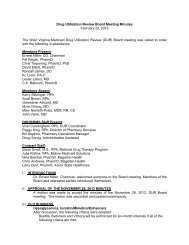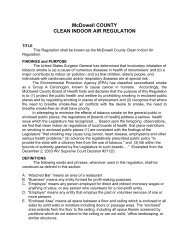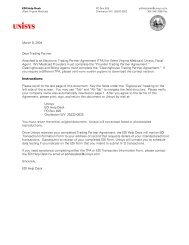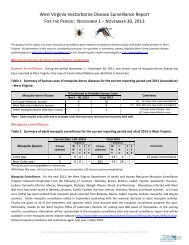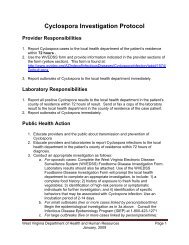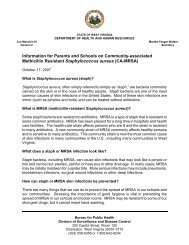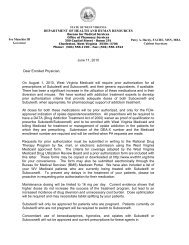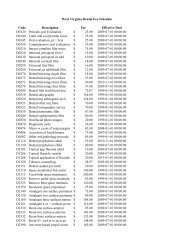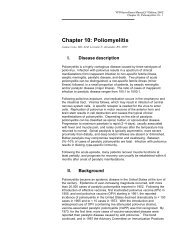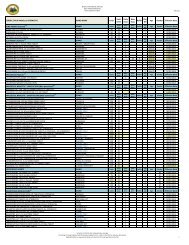Protocol for the Surveillance of Coxiella burnetii (Q-Fever) - DHHR
Protocol for the Surveillance of Coxiella burnetii (Q-Fever) - DHHR
Protocol for the Surveillance of Coxiella burnetii (Q-Fever) - DHHR
Create successful ePaper yourself
Turn your PDF publications into a flip-book with our unique Google optimized e-Paper software.
August, 2013Q <strong>Fever</strong><strong>Surveillance</strong> <strong>Protocol</strong>ii. Evaluation suspected source <strong>of</strong> exposure (i.e., site visit andpossible environmental sampling or sampling <strong>of</strong> animal products)iii. Case-control or retrospective cohort studiesiv. Trace-back studiesc. During field investigation, anticipate <strong>the</strong> need <strong>for</strong> occupational healthprotections commensurate with <strong>the</strong> environment, e.g.:i. In farm environments, follow WV Department <strong>of</strong> Agricultureprotocols.ii. Seek expert consultation <strong>for</strong> field investigation <strong>of</strong> a laboratory orresearch facility exposure.State Health Department Responsibilities1. Review reported cases and submit to CDC (standard notification) after assuringthat case ascertainment is correct and an adequate risk factor investigation hasbeen completed.2. Assist with outbreak investigation, to include:a. Liaison with West Virginia Department <strong>of</strong> Agriculture, USDA and CDC toassure that animal investigation can be completed as required.b. Serve as primary lead on design <strong>of</strong> epidemiological studies, if needed.c. Development <strong>of</strong> questionnaires and line lists.d. Assist with site visits and laboratory testing to evaluate exposurehypo<strong>the</strong>ses.e. For suspected or confirmed deliberate exposure events, liaison with lawen<strong>for</strong>cement and CDC.Disease Prevention ObjectivesReduce risk through educating <strong>the</strong> public to:o Consume only pasteurized dairy products.o Practice hand hygiene appropriately after contact with animals and animalproductso Have animal illness evaluated promptly by a veterinarianDisease Control Objectives In <strong>the</strong> event <strong>of</strong> an outbreak, reduce <strong>the</strong> number <strong>of</strong> cases by:Division <strong>of</strong> Infectious Disease Epidemiology350 Capitol Street, Room 125, Charleston, WV 25301-3715Phone: 304.558.5358 Fax: 304.558.6335 www.dide.wv.govPage 2 <strong>of</strong> 9
August, 2013Q <strong>Fever</strong><strong>Surveillance</strong> <strong>Protocol</strong>oIdentifying point source <strong>of</strong> infection and removing it. Examples <strong>of</strong>possible point sources include: infected herd animals, laboratorycontamination, contaminated animal products, etc.<strong>Surveillance</strong> ObjectivesRapidly detect cases and outbreaks <strong>of</strong> Q feverIdentify demographic characteristics <strong>of</strong> persons with Q fever.Characterize and describe risk factors <strong>for</strong> Q fever.Public Health SignificanceQ fever was first described in Australia as “Query <strong>Fever</strong>” because <strong>the</strong> causative agentwas not known. Q fever became a nationally notifiable disease in <strong>the</strong> United States in1999, but reporting is not required in many o<strong>the</strong>r countries. Because <strong>the</strong> disease isunderreported, it is not known how many cases <strong>of</strong> Q fever have actually occurredworldwide. Many human cases are inapparent.Human outbreaks can result from <strong>the</strong> inhalation <strong>of</strong> aerosolized organisms, especiallyfrom barnyard dust contaminated by bacteria from animal urine, feces and birthproducts. Sporadic cases occur in people who are occupationally exposed, affectingveterinarians, meat workers, sheep and occasionally dairy workers, and farmers.Epidemics have occurred among workers in stockyards, meatpacking and renderingplants, and laboratories, and in medical and veterinary medical centers that use sheep,especially pregnant ewes, in research. Individual cases may occur, however, where nodirect animal contact can be demonstrated.One hundred thirty-two cases <strong>of</strong> Q fever were reported with onset in 2008, <strong>the</strong> mostrecent year where data is available. Of <strong>the</strong>se, 117 were acute Q fever and 15 werechronic Q fever. Cases <strong>of</strong> Q fever are most frequently reported from western andplains states where ranching and rearing <strong>of</strong> cattle are common. Seven states(Cali<strong>for</strong>nia, Colorado, Illinois, Kentucky, Missouri, Tennessee, and Texas) haveaccounted <strong>for</strong> more than half (52%) <strong>of</strong> all cases since human Q fever becamenotifiable. Cases <strong>of</strong> Q fever are reported less frequently in <strong>the</strong> eastern United States.The causative agent, <strong>Coxiella</strong> <strong>burnetii</strong>, is resistant to heat, drying, and many commonDivision <strong>of</strong> Infectious Disease Epidemiology350 Capitol Street, Room 125, Charleston, WV 25301-3715Phone: 304.558.5358 Fax: 304.558.6335 www.dide.wv.govPage 3 <strong>of</strong> 9
August, 2013Q <strong>Fever</strong><strong>Surveillance</strong> <strong>Protocol</strong>disinfectants. These features enable <strong>the</strong> bacteria to survive <strong>for</strong> long periods in <strong>the</strong>environment. That, coupled with <strong>the</strong> facts that humans are <strong>of</strong>ten very susceptible to <strong>the</strong>disease, very few organisms are required to cause illness, and <strong>the</strong> organism is highlyinfectious by <strong>the</strong> aerosol route, make C. <strong>burnetii</strong> a possible biological warfare agent.Clinical DescriptionQ fever is <strong>of</strong>ten asymptomatic or mild. Over 20% <strong>of</strong> U.S. veterinarians, <strong>for</strong> example,have antibodies <strong>for</strong> Q fever. Many persons with Q fever antibodies do not recall asevere illness.Among recently infected persons, clinical signs vary greatly. The most commonmanifestation is a self-limited flu-like syndrome characterized by high (104 ◦ F) feverlasting 1-3 weeks, fatigue, headache and myalgias. Atypical pneumonia, whenrecognized, is <strong>of</strong>ten mild, with a case fatality rate <strong>of</strong> 0.5 to 1.5%. Hepatitis is also verycommon. Elevated liver function tests are found in 85% <strong>of</strong> patients. Overt jaundice israre. O<strong>the</strong>r acute syndromes include acute pericarditis and/or myocarditis ormeningoencephalitis. Clinical laboratory findings may also include elevatedthrombocytopenia, elevated sedimentation rate, and abnormal chest film findings.Many persons with acute Q fever recover spontaneously and do not require treatment.However, persons with risk factors <strong>for</strong> chronic infection (heart valve or vascular defect)should be monitored closely per reference 2.Chronic infection develops insidiously over many months to years in less than 5 % <strong>of</strong>patients with acute infection. Untreated, mortality rate is 100%. Endocarditis is <strong>the</strong>primary <strong>for</strong>m <strong>of</strong> chronic disease. Aortic aneurysms and infections <strong>of</strong> <strong>the</strong> bone, liver, orreproductive organs may also occur. Chronic Q fever usually occurs inimmunosuppressed persons or those with valvular heart disease or vascular grafts.In pregnant women, Q fever may result in spontaneous abortion, fetal death, placentitisor thrombocytopenia. Q fever in pregnant women may present as subclinical ornonspecific febrile illness; or atypical pneumonia, hepatitis or o<strong>the</strong>r seriousmanifestations. Q fever can also recur during later pregnancies. Pregnant women withQ fever should be treated because <strong>of</strong> <strong>the</strong> high risk <strong>of</strong> fetal complications.Division <strong>of</strong> Infectious Disease Epidemiology350 Capitol Street, Room 125, Charleston, WV 25301-3715Phone: 304.558.5358 Fax: 304.558.6335 www.dide.wv.govPage 4 <strong>of</strong> 9
August, 2013Q <strong>Fever</strong><strong>Surveillance</strong> <strong>Protocol</strong>chronic infections. Because <strong>of</strong> <strong>the</strong> zoonotic nature <strong>of</strong> C. <strong>burnetii</strong>, <strong>the</strong> variable clinicalmanifestations, and difficult diagnosis, it is possible that a small deliberate releasemight go unrecognized. C. <strong>burnetii</strong> should be considered as a possible etiology <strong>for</strong> alarge influenza like illness and pneumonia outbreak outside <strong>of</strong> influenza season.Case DefinitionAcuteProbable Q fever: A clinically compatible case <strong>of</strong> acute illness (meets clinical evidencecriteria <strong>for</strong> acute Q fever illness) that has laboratory supportive results <strong>for</strong> past orpresent acute disease (antibody to Phase II antigen) but is not laboratory confirmed.Confirmed Q fever: A laboratory confirmed case that ei<strong>the</strong>r meets clinical case criteriaor is epidemiologically linked to a lab confirmed case.ChronicProbable Q fever: A clinically compatible case <strong>of</strong> chronic illness (meets clinicalevidence criteria <strong>for</strong> chronic Q fever) that has laboratory supportive results <strong>for</strong> past orpresent chronic infection (antibody to Phase I antigen).Confirmed Q fever: A clinically compatible case <strong>of</strong> chronic illness (meets clinicalevidence criteria <strong>for</strong> chronic Q fever) that is laboratory confirmed <strong>for</strong> chronic infection.Laboratory DiagnosisBecause <strong>the</strong> signs and symptoms <strong>of</strong> Q fever are not specific to this disease, it is difficultto make an accurate diagnosis without appropriate laboratory testing.Laboratory diagnosis <strong>of</strong> Q-<strong>Fever</strong> is made by finding: Fourfold or greater change in antibody titer to <strong>Coxiella</strong> <strong>burnetii</strong> Phase I or PhaseII antigen in paired serum specimens ideally taken 3-6 weeks apart, or Isolation <strong>of</strong> C. <strong>burnetii</strong> from a clinical specimen by culture, or Demonstration <strong>of</strong> C. <strong>burnetii</strong> in a clinical specimen by detection <strong>of</strong> antigen orDivision <strong>of</strong> Infectious Disease Epidemiology350 Capitol Street, Room 125, Charleston, WV 25301-3715Phone: 304.558.5358 Fax: 304.558.6335 www.dide.wv.govPage 7 <strong>of</strong> 9
August, 2013Q <strong>Fever</strong><strong>Surveillance</strong> <strong>Protocol</strong>women should be treated with trimethoprim/sulfamethoxazole. For fur<strong>the</strong>r in<strong>for</strong>mationabout treatment, visit http://www.cdc.gov/mmwr/preview/mmwrhtml/rr6203a1.htm.<strong>Surveillance</strong> IndicatorsTime between suspicion <strong>of</strong> Q fever and first report to public health.Completeness <strong>of</strong> investigation, including risk factor and exposure data collection.References1. Amitaj Z, Bromberg M, Bernstein M, et.al. A large Q fever outbreak in an urbanschool in central Israel. Clin Infect Dis, 2010; 50:1433-1438.2. Centers <strong>for</strong> Disease Control and Prevention. Diagnosis and management <strong>of</strong> Qfever – United States, 2013. Recommendations from CDC and <strong>the</strong> Q feverworking group. MMWR, 62(RR 3):1-28.3. Faix DJ, Harrison DJ, Riddle MS, et.al. Outbreak <strong>of</strong> Q fever among US militaryin Western Iraq, June-July 2005. Clin Infect Dis, 2008; 46:e65-8.4. Fournier P-E, Marrie TJ and Raoult D. Diagnosis <strong>of</strong> Q fever. J Clin Microbiol,1998; 36:1823-1-34.5. Oyston PCF, Davies C. Q fever: <strong>the</strong> neglected biothreat agent. J MedMicrobiol, 2011; 60:9-21.6. Roest HIJ, Tilburg JJHC, Van Der Hoek W, et.al. The Q fever epidemic in TheNe<strong>the</strong>rlands: history, onset, response and reflection. Epidemiol Infect, 2011;139:1-12.7. Signs KA Stobierski MG, Gandhi TN. Clin Infect Dis, 2012; 55:1387-9.8. Stein A and Raoult D. Q fever during pregnancy: a public health problem inSou<strong>the</strong>rn France. Clin Infect Dis, 1998; 27:592-6.9. Whitney EAS, Massung RF, Candee AJ, et.al. Seroepidemiologic andoccupational risk survey <strong>for</strong> <strong>Coxiella</strong> <strong>burnetii</strong> antibodies among US veterinarians.Clin Infect Dis, 2009; 48:550-7.Division <strong>of</strong> Infectious Disease Epidemiology350 Capitol Street, Room 125, Charleston, WV 25301-3715Phone: 304.558.5358 Fax: 304.558.6335 www.dide.wv.govPage 9 <strong>of</strong> 9





